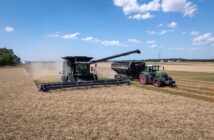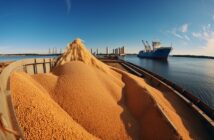The latest AHDB Grain Market Report is again rather grim reading. Grain prices have continued to slide as competitive Black Sea supplies continue to impact EU export demand.
UK feed wheat futures (May-24) fell by more than £5.00/t over the week and closed on Thursday 15th February at £165.70/t. New crop futures (Nov-24) fell by a similar value ending the session at £184.35/t.
FranceAgriMer estimated yesterday that French soft wheat ending stocks for the 2023/24 season would reach 3.5 Mt, up from last month’s estimate of 3.44 Mt and up 37% on the year (LSEG).
Despite downward pressure in US soyabean markets, Paris rapeseed futures (May-24) recovered from the previous week, closing on the 15th at €424.50/t. The Nov-24 contract also gained, ending at €428.75/t.
Straw prices on the rise
With straw supplies expected to tighten through 2024, prices could return to those seen in 2020/21 or higher. Due to the wet summer, autumn and winter of 2023 it is reshaping the straw market.
Harvest 2022 was the perfect year to bale straw. A dry harvest enabled straw to be moved off fields swiftly, with reduced risks of soil compaction. Dry weather also meant that wet straw waiting to dry in the field wasn’t delaying establishment of the following crop. This created an increased incentive for farmers to bale and sell their straw, creating a glut in the market.
But 2023 couldn’t have been more different to 2022. Wet soils (less able to support balers and trailers) and wet straw waiting to be removed delayed establishment of the following crop. Understandably, some farmers weren’t willing to embrace the risks, and instead decided to chop the straw and return it to the soil.
Also in 2023, the realisation of higher fertiliser costs was starting to be felt on the ground. With limited increases in straw prices by harvest 2023, this meant that arable farmers were less able to recover the value of crop nutrients being lost when straw was moved off the farm.
The market is now reflecting the reality, with barley straw at £80 per tonne and wheat straw £70 per tonne for the first time since mid-2021.
Straw prices have been later to suffer from inflation compared with other farm inputs. However, prices are now rising quickly and will result in the highest bedding costs seen for several years – this is not good news for businesses that are significant users of straw. The weather of the last six months has not only reduced the current supply, but it also casts doubt over the scale of the 2024 harvest.
In line with history, a period of high straw prices will likely challenge livestock businesses to consider alternative materials. However, without significant change in farm infrastructure (including manure management) this is easier said than done.
Thankfully, the escalation in straw prices didn’t come in 2022 when other costs were inflating massively. But the fall in other costs, such as feed, will be offset to an extent by the need to pay higher straw prices through 2024.




